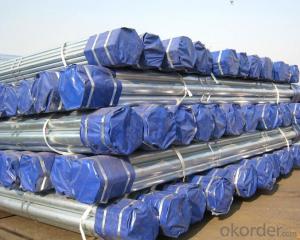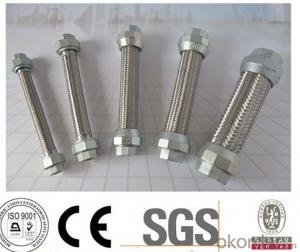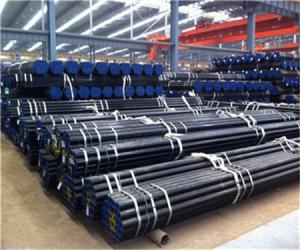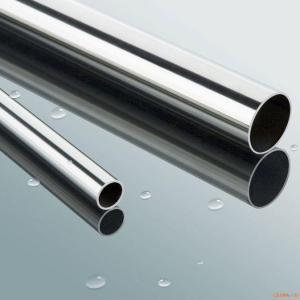Galvanized Stainless Steel Pipes With Good Price
- Loading Port:
- China main port
- Payment Terms:
- TT or LC
- Min Order Qty:
- 100 m.t.
- Supply Capability:
- 10000 m.t./month
OKorder Service Pledge
OKorder Financial Service
You Might Also Like
1、Structure of Seamless Pipe :
Seamless pipe is formed by drawing a solid billet over a piercing rod to create the hollow shell, so it is regarded as withstanding pressure better than other types, and is often more easily available than welded pipe.
2、Main Features of the Seamless Pipe :
• Good visual effect
• Reasonable price
• High manufacturing accuracy
• High strength
• Small inertia resistance
• Strong heat dissipation ability
3、Seamless Pipe Specification:
1) Material:20#(ASTM A 106/A53 GRB.API5LGRB,GB),45#,16Mn,10#.
2) Specification range:OD:21.3-610mm,WT:6-70mm,length:6-12m or according to the requirement of clients.
3) Excutive standards:GB,ASME API5L.ASTM A 106/A53,Despite of the above standards,we can also supply seamless steel pipe with standard of DIN,JIS,and so on,and also develop new products according to the requirements of our clients!
4) Surface:black lacquered,varnish coating or galvanized.
5) Ends:Beveled or square cut,plastic capped,painted.
6) Packing:bundles wrapped with strong steel strip,seaworthy packing.
4、Packaging & Delivery
Packaging Details: | seaworthy package,bundles wrapped with strong steel strip |
Delivery Detail: | 15-30days after received 30%TT |
5、FAQ of Seamless Pipe :
①How is the quality of your products?
If you want see our quality certifications and all kinds of testing report, please just ask us for it.
Guaranteed: If products’ quality don’t accord to discription as we give or the promise before you place order, we promise 100% refund.
②How about price?
We quote as lowest as possible for any customer, and discount can be given according to quantity”,if you like bargain and factory price is not low enough as you think, just don’t waste your time.Please trust the quotation we would give you, it is professional one.
③Why should you chose us?
Our service formula: good quality+good price+good service=customer’s trust
SGS test is available, customer inspection before shipping is welcome, third party inspection is no problem.
Any question, pls feel free to contact us !
6、Seamless Pipe Images


- Q: Can stainless steel pipes be insulated with polytetrafluoroethylene?
- Yes, stainless steel pipes can be insulated with polytetrafluoroethylene (PTFE). PTFE is a high-performance polymer known for its excellent thermal and chemical resistance. It can withstand a wide temperature range (-200°C to +260°C) and is highly resistant to corrosion and chemical attack. These properties make PTFE a suitable material for insulating stainless steel pipes in various industrial applications. When used as insulation for stainless steel pipes, PTFE can provide thermal insulation to prevent heat loss or gain. It helps maintain the desired temperature of the fluid flowing through the pipes, which is crucial in applications where temperature control is essential, such as in chemical processing plants or food processing facilities. PTFE insulation also acts as a barrier against condensation, preventing moisture build-up on the pipe's surface. Furthermore, PTFE's low friction coefficient makes it easier for liquids to flow through the pipes, reducing pressure drop and improving overall system efficiency. It also has excellent electrical insulation properties, which can be advantageous in applications where electrical conductivity needs to be avoided. Overall, PTFE is a reliable and effective insulation material for stainless steel pipes, providing thermal, chemical, and electrical insulation properties, as well as corrosion resistance.
- Q: Can stainless steel pipes be used for sewage systems?
- Yes, stainless steel pipes can be used for sewage systems. Stainless steel is a highly durable and corrosion-resistant material, making it suitable for various applications, including sewage systems. Stainless steel pipes are capable of withstanding the harsh elements found in sewage, such as corrosive chemicals, high temperatures, and abrasive solids. Additionally, stainless steel pipes have a smooth surface, which minimizes the risk of clogs and blockages in the sewage system. This makes stainless steel pipes a reliable and long-lasting choice for sewage systems, ensuring efficient and effective waste disposal.
- Q: How do stainless steel pipes compare to PVC pipes?
- Stainless steel pipes are generally more durable, have higher heat resistance, and are better suited for high-pressure applications compared to PVC pipes. While PVC pipes are lightweight, cost-effective, and easier to install, they are prone to cracking, chemical reactions, and may not be suitable for certain environments. Therefore, the choice between stainless steel and PVC pipes depends on the specific needs of the application.
- Q: Can stainless steel pipes be used for pulp and paper industry applications?
- Stainless steel pipes are indeed suitable for use in various applications within the pulp and paper industry. Due to their exceptional durability and resistance to corrosion, stainless steel pipes can be utilized in a range of industrial settings, including those found in the pulp and paper sector. This industry involves the transportation of corrosive substances and fluids, such as acids, bleaching agents, and solvents, which have the potential to deteriorate and erode standard pipes over time. Conversely, stainless steel pipes possess corrosion resistance properties, enabling them to endure the harsh chemicals and elevated temperatures typically encountered in pulp and paper plants. Furthermore, these pipes are also known for their hygienic nature and ease of cleaning, rendering them highly suitable for applications where cleanliness is of utmost importance, such as in the production of food-grade paper. In summary, stainless steel pipes represent a dependable and long-lasting choice for the pulp and paper industry.
- Q: What is the difference between 2205 and 316L stainless steel pipes?
- The main difference between 2205 and 316L stainless steel pipes lies in their composition and properties. 2205 stainless steel is a duplex stainless steel, meaning it consists of a combination of austenite and ferrite phases. This composition provides excellent corrosion resistance and high strength. It is commonly used in applications that require resistance to stress corrosion cracking, such as marine environments and chemical processing plants. On the other hand, 316L stainless steel is an austenitic stainless steel known for its high corrosion resistance. It contains a higher percentage of chromium and nickel, which gives it superior resistance to pitting and crevice corrosion. It is commonly used in industries such as food processing, pharmaceuticals, and medical devices. In summary, while both 2205 and 316L stainless steel pipes offer corrosion resistance, 2205 provides higher strength and resistance to stress corrosion cracking, while 316L offers better resistance to pitting and crevice corrosion. The choice between the two will depend on the specific requirements of the application.
- Q: What are the different grades of stainless steel used in pipes?
- There are several different grades of stainless steel that are commonly used in pipes, each with its own unique properties and characteristics. The most commonly used grades include: 1. Stainless Steel Grade 304: This is one of the most versatile and widely used grades of stainless steel. It is non-magnetic, has excellent corrosion resistance, and is easily weldable. Grade 304 is commonly used in applications where hygiene and cleanliness are important, such as in food processing plants, hospitals, and pharmaceutical industries. 2. Stainless Steel Grade 316: This grade is known for its superior corrosion resistance, especially in environments with high chloride content or exposure to saltwater. Grade 316 is often used in marine applications, chemical processing plants, and coastal areas where corrosion resistance is crucial. 3. Stainless Steel Grade 321: Grade 321 is stabilized with titanium, making it more resistant to sensitization and intergranular corrosion at elevated temperatures. It is commonly used in high-temperature applications, such as exhaust systems, furnaces, and heat exchangers. 4. Stainless Steel Grade 409: This grade is specifically designed for high-temperature applications, such as automotive exhaust systems. It has excellent heat resistance and low thermal expansion properties, making it ideal for withstanding extreme temperatures. 5. Stainless Steel Grade 904L: Grade 904L has high corrosion resistance and is particularly resistant to pitting and crevice corrosion. It is commonly used in aggressive environments, such as chemical processing plants, offshore oil and gas platforms, and pulp and paper industries. These are just a few examples of the different grades of stainless steel used in pipes. The choice of grade depends on the specific application and the desired properties, such as corrosion resistance, temperature resistance, and mechanical strength.
- Q: Can stainless steel pipes be used for pharmaceutical storage?
- Yes, stainless steel pipes can be used for pharmaceutical storage. Stainless steel is a highly durable and corrosion-resistant material, making it ideal for storing pharmaceutical products. It is easy to clean, maintains the integrity of the stored materials, and does not react with the pharmaceutical substances. Additionally, stainless steel pipes have smooth surfaces, which prevent the accumulation of bacteria and contaminants. This makes stainless steel pipes a suitable option for pharmaceutical storage where maintaining hygiene and purity is crucial.
- Q: Can stainless steel pipes be bent or shaped?
- Stainless steel pipes possess the capability to undergo bending or shaping. Their favorable ductility allows for easy transformation into various shapes and configurations. Specialized equipment, including pipe bending machines or hydraulic presses, are commonly utilized to achieve this. By applying pressure at specific points, these tools induce the desired bend or formation in the pipe. The extent of bending or shaping depends on factors such as the pipe's diameter, thickness, and the desired angle or curvature. It is crucial to exercise caution during the bending process to prevent any harm or distortion to the stainless steel pipe.
- Q: What is the difference between 410 and 316 stainless steel pipes?
- The chemical composition and intended applications set 410 and 316 stainless steel pipes apart. 410 stainless steel, a martensitic type, contains a higher carbon content ranging from 0.15% to 0.25% and a relatively lower chromium content between 11.5% and 13.5%. This composition grants 410 stainless steel pipes remarkable strength, hardness, and wear resistance. It is frequently employed in situations where corrosion resistance is not the primary concern, such as cutting tools, knives, and firearm components. On the flip side, 316 stainless steel is an austenitic variety with a higher chromium content, ranging from 16% to 18%, along with a significant nickel content between 10% and 14%. This composition provides 316 stainless steel pipes with exceptional corrosion resistance, particularly in environments containing chlorides or other corrosive agents. It finds widespread use in industries such as chemical processing, pharmaceuticals, food processing, and marine applications. To sum up, the primary distinction between 410 and 316 stainless steel pipes lies in their chemical composition and resulting properties. 410 stainless steel offers superior strength and hardness but has lower corrosion resistance compared to 316 stainless steel, which boasts high corrosion resistance but may have slightly reduced strength and hardness. The selection between the two depends on the specific requirements of the application, with 410 stainless steel being better suited for situations where strength and wear resistance are paramount, while 316 stainless steel is the preferred choice for applications demanding excellent corrosion resistance.
- Q: What is the difference between seamless and drawn-over-mandrel stainless steel pipes?
- The manufacturing process and physical properties set seamless stainless steel pipes and drawn-over-mandrel (DOM) stainless steel pipes apart. When it comes to seamless stainless steel pipes, a solid cylindrical billet of stainless steel is pierced and then extruded to create a seamless tube. This process guarantees a uniform and consistent thickness throughout the pipe, resulting in a flawless and seamless look. Seamless pipes are renowned for their exceptional strength and resistance to pressure, making them suitable for applications that demand reliable and resilient piping systems. On the other hand, drawn-over-mandrel stainless steel pipes are formed by transforming a solid cylindrical billet into a hollow tube through a series of drawing operations. A mandrel is then used to refine the tube's shape and size accuracy. This method ensures that the pipe has a uniform wall thickness and a smooth inner surface. DOM pipes are known for their precise dimensions and tight tolerances, which make them ideal for applications that require exact fitting and unobstructed flow, such as those found in the automotive and hydraulic industries. In terms of physical properties, seamless stainless steel pipes generally boast higher tensile strength and yield strength compared to DOM pipes. This characteristic makes seamless pipes more suitable for high-pressure and high-stress applications, like those found in the oil and gas industry. DOM pipes, on the other hand, excel in dimensional control and surface finish, making them perfect for applications that require precise dimensions and smooth flow, such as those found in the automotive and hydraulic industries. To summarize, the primary difference between seamless and drawn-over-mandrel stainless steel pipes lies in their manufacturing process and physical properties. Seamless pipes are created by extruding a solid billet, resulting in a smooth and seamless appearance. DOM pipes, on the other hand, are formed by drawing a hollow tube from a solid billet, resulting in exceptional dimensional accuracy. The choice between these two pipe types depends on the specific requirements of the application, including pressure resistance, dimensional accuracy, and surface finish.
Send your message to us
Galvanized Stainless Steel Pipes With Good Price
- Loading Port:
- China main port
- Payment Terms:
- TT or LC
- Min Order Qty:
- 100 m.t.
- Supply Capability:
- 10000 m.t./month
OKorder Service Pledge
OKorder Financial Service
Similar products
Hot products
Hot Searches
Related keywords


























